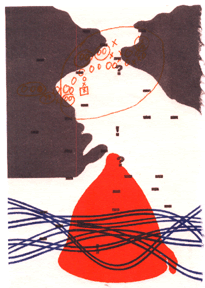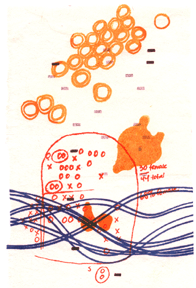
Where the Visual Meets the Verbal
Robert Miltner
continued . . .
![]()
Collaborative Encounters for the First Time
 My own experiences with interdisciplinary collaboration took place over the past two years. In the fall of 1999, I was invited to participate in "The Visual Word," a joint project sponsored by the Poets' League of Greater Cleveland and Zygote Press, a Cleveland printmaking cooperative. I submitted two poems, and a printmaker selected one of the poems, creating a print in response.
My own experiences with interdisciplinary collaboration took place over the past two years. In the fall of 1999, I was invited to participate in "The Visual Word," a joint project sponsored by the Poets' League of Greater Cleveland and Zygote Press, a Cleveland printmaking cooperative. I submitted two poems, and a printmaker selected one of the poems, creating a print in response.  When I attended the exhibit in January of 2000, and met the printmaker, Wendy Collin Sorin, I was amazed at her visual images, as well as the inclusive text (letter excerpts and mathematical equations), let alone the textures and colors of the print in response to my poem; suddenly, my way both of looking at and speaking about my own work became enriched, and my vocabulary for speaking about the collaborative experience expanded. What began that day has become an ongoing dialogue with myself concerning the relationship between poetry and printmakeing, between the visual and the verbal arts; between Wendy Collin Sorin and myself concerning collaborative efforts between the two of us; and between myself and other artists working in diverse mediums, since the act of collaboration is an engagement in a conversation about art.
When I attended the exhibit in January of 2000, and met the printmaker, Wendy Collin Sorin, I was amazed at her visual images, as well as the inclusive text (letter excerpts and mathematical equations), let alone the textures and colors of the print in response to my poem; suddenly, my way both of looking at and speaking about my own work became enriched, and my vocabulary for speaking about the collaborative experience expanded. What began that day has become an ongoing dialogue with myself concerning the relationship between poetry and printmakeing, between the visual and the verbal arts; between Wendy Collin Sorin and myself concerning collaborative efforts between the two of us; and between myself and other artists working in diverse mediums, since the act of collaboration is an engagement in a conversation about art.
This spring, I was invited to participate in the second phase of the project between the Poets' League of Greater Cleveland and Zygote Press, "The Poetic Image," which involved twenty-three poets and twenty-six printmakers. In this instance, I was given four diptych prints by Wendy Collin Sorin and was asked to write in response to one of them. When I got home from picking up the prints at Zygote Press, I set up all four in good light in the living room, hoping something would suggest itself. What happened was unlike any writing experience I had previously experienced: as I looked at the prints, I began to see images—in this case, wings, chromosomes, sign language figures, numbers—presented in interconnected pairs. As I started to write, I found I was "listening" to the prints as they "spoke" to me; the more I wrote, the more I found myself in dialogue with the prints. The result was a suite of four poems—"The Connection between Roman Numerals and Letters," "Calculating Machine," "Painting on Smoke," and "A System of Familiar Philosophy"—borrowing the titles of the prints, and extended the previous range of my work; after all, by responding verbally to visual art, I had crossed a border into a new, visual realm, transgressing the text-bound limits of my own imagination and working vocabulary. What I found, through this dialogue, were new additions of words and images which enriched and extended my vocabulary as a writer. What I discovered further was that this extension of my vocabulary allowed me to extend my dialogue with the printmaker, in that this increased vocabulary made it possible for me to discuss both the prints and my own poems in ways I had previously been unable to do, given my limited poetic orientation to the creative act. What I discovered ultimately was that I was now capable of engaging in a richer, more comprehensive dialogue on the creative process, regardless of medium, and of engaging in more interdisciplinary conversation, empowered as I now was with an expanded vocabulary for discussing the arts.
Concerning her experiences in our recent collaboration, the printmaker with whom I collaborated on both "The Visual Word" and "The Poetic Image," Wendy Collin Sorin, commented to me that:
My first read-through of your work left me breathless. That is the magic of this collaboration thing, something apart yet very close in feeling to the rush I feel when I do my own work, alone. There is this "ah-ha," a knowing that it's right, close to the bone. It's those highs that keep me at it. . . . I love to see and hold and listen to the final product but in a way that's only the physical record, what remains of the intensity of the experience. . . . Thank you for the energy exchange, this dialogue. (Email to the author 29 May 2000; my emphasis)
In our discussions, we've unearthed a common metaphor for our collaborations: it is like two musicians playing together, each working off of the other, duet or jam session; considering how Wendy used to play piano while her father sang, and how I played guitar in high school rock and roll bands, we find that our visual and verbal collaboration reclaims what we once found in making music.
|
Copyright © Enculturation 2001 |